While the cost of fertiliser has dropped back from its peak a few years ago, it still represents a huge cost to growers, and with greater focus on the environmental impact – both of the production and spreading of fertiliser products – there is more emphasis than ever on minimising spreading while maximising returns.
It’s no surprise then that the bulk of the updates within this sector has been focused on precision applications. Going beyond variable rate and section control, manufacturers have integrated new border spreading systems to reduce the risk of spreading outside a field boundary.
Similarly, clever technology can adjust the drop point of the fertiliser on the fly, creating new spread patterns and adjusting the rate in real time.
There has also been a resurgence in boom-mounted spreaders, which broaden the weather window for operations as granules are less susceptible to wind. According to the companies, these machines can also limit the effect fertiliser quality has on the operation, as the working width is not determined by this.
Of course, versatility can influence the investment as well, with larger trailed machines often available with lime spreading kits. This extends the usability of the machinery purchased, as well as coming with additional benefits such as increased hopper capacities and, in some cases, a wider spread width when working with fertiliser.
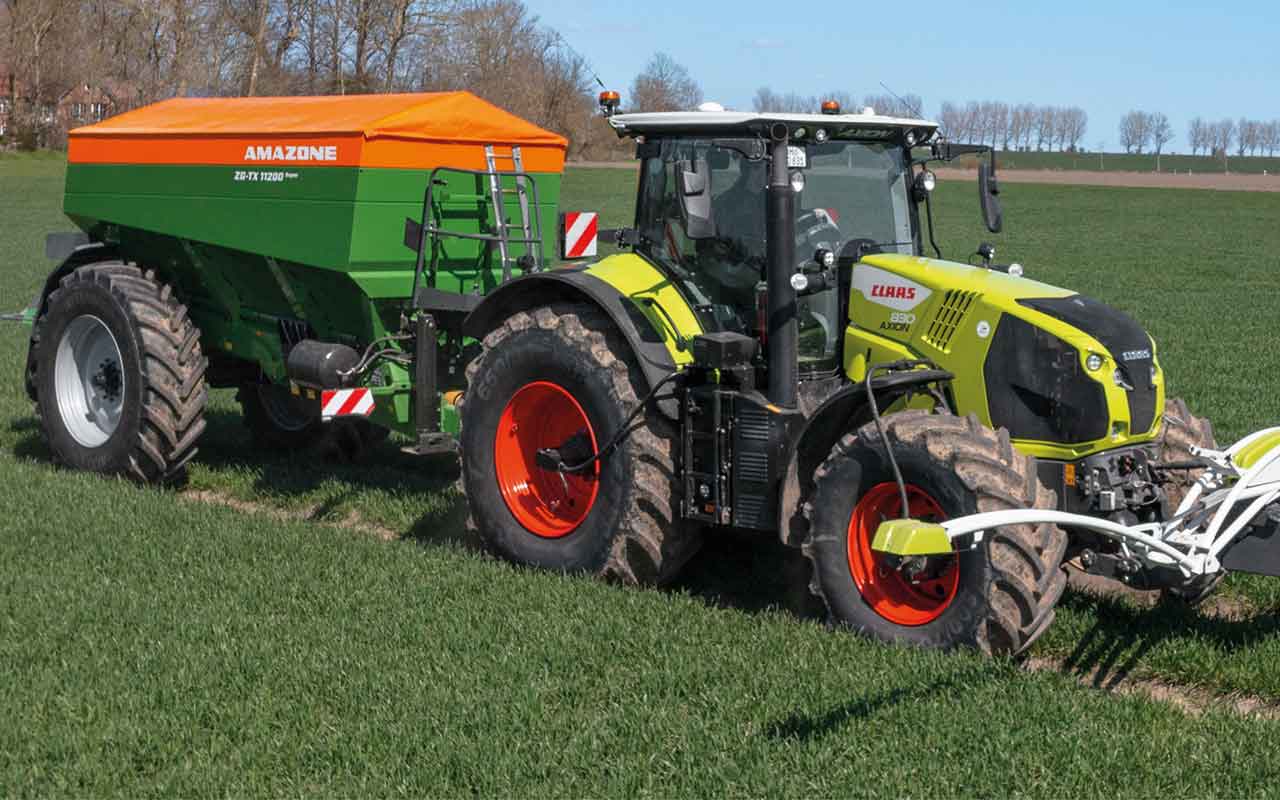
Amazone
The Amazone range consists of seven distinct models, with mounted versions topping out with the ZA-TS, offering a maximum capacity of 5,000 litres, spread widths up to 54m and the option of weigh cells.
The company’s trailed models are headed up by the ZG-TX, with a huge capacity of 11,200 litres, working widths up to 54m in fertiliser and the ability to spread lime up to 16m.
To limit variations in the spread width, Amazone machines automatically adjust the point at which the fertiliser is dropped onto the disc as the spread rate goes up or down.
When dealing with varying quality and granule size, operators can also use the mySpreader app to aid with setup, with the ability to transfer settings from the app to an Isobus-connected machine.
TS and the ZG-TX machines benefit from the AutoTS system for accurate application up against the headland, giving a short, sharp cut-off against the field boundary, said to boost yields by up to 17%.
The company also offers protection against adverse weather with the WindControl system, which adjusts the disc speed and drop point to maintain the correct spread.
Software improvements for 2025 include the AmaTron Share App for easier data transfer between spreader and PC, as well as ScenarioControl for automated spreading sequences for optimising turns, filling, switch points and headland spreading without any input from the driver.
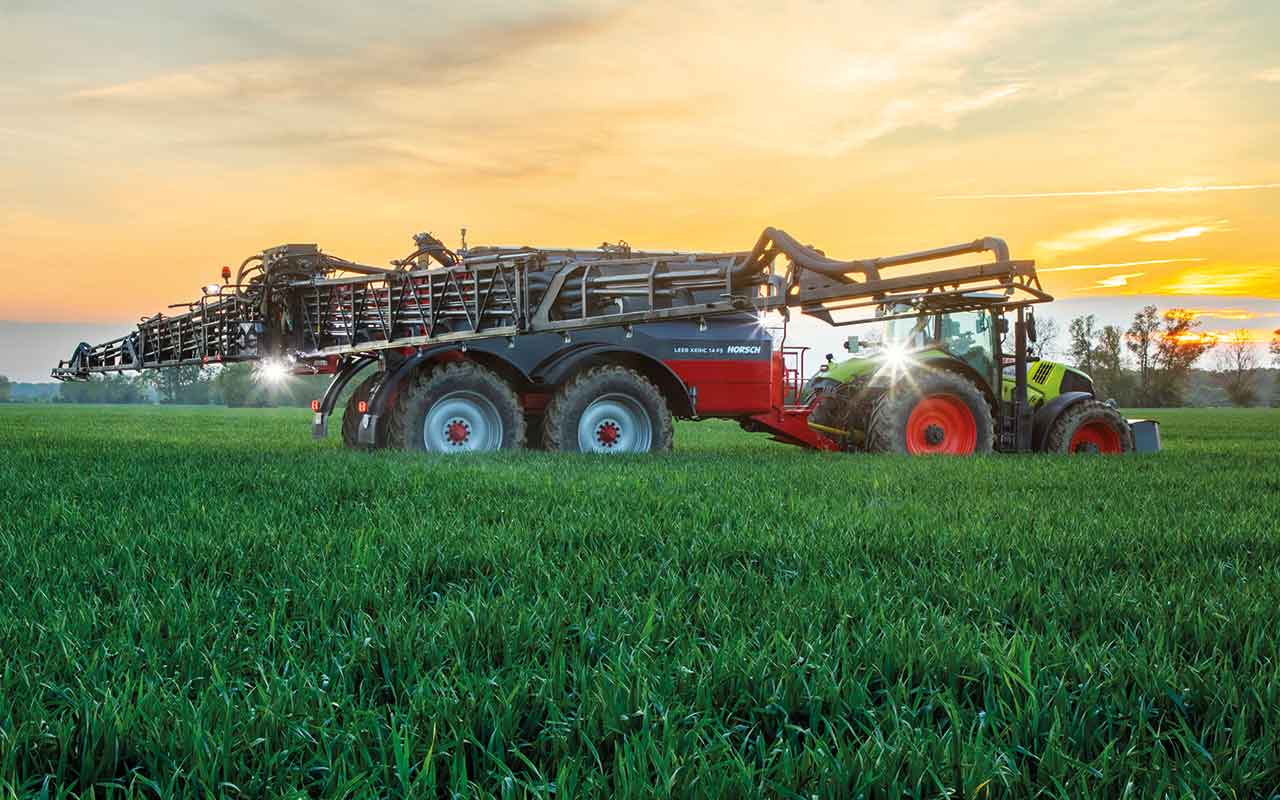
Horsch
Horsch entered the fertiliser spreader market last year with the announcement of the Leeb Xeric, a trailed spreader with a boom, designed to offer sprayer-level accuracy with granular products.
The company says the development came about in recognition of the short time window for spreading fertiliser. As such, the machine offers a large capacity of 14cu m and boom widths of 36m or 48m.
Combined with a powerful metering output and high operational speeds up to 20kph, the Leeb Xeric can offer a high output for operators with large areas to cover.
It is based on the proven tandem-axle chassis of the Leeb 12 TD sprayer, with active steering of both axles for a turning angle of up to 28deg, which allows for a precise following as well as fitment of large-diameter tyres.
It carries over many of the same features. The Leeb Xeric features BoomControl for precise boom levelling, a metering box with a central metering system and a new boom design with a smooth passage for the fertiliser.
This allows for a precise longitudinal and lateral distribution and application, regardless of wind or bad fertiliser quality. Advanced features like a 12-section boom, automatic section switch-off and curve compensation are included to offer greater precision.
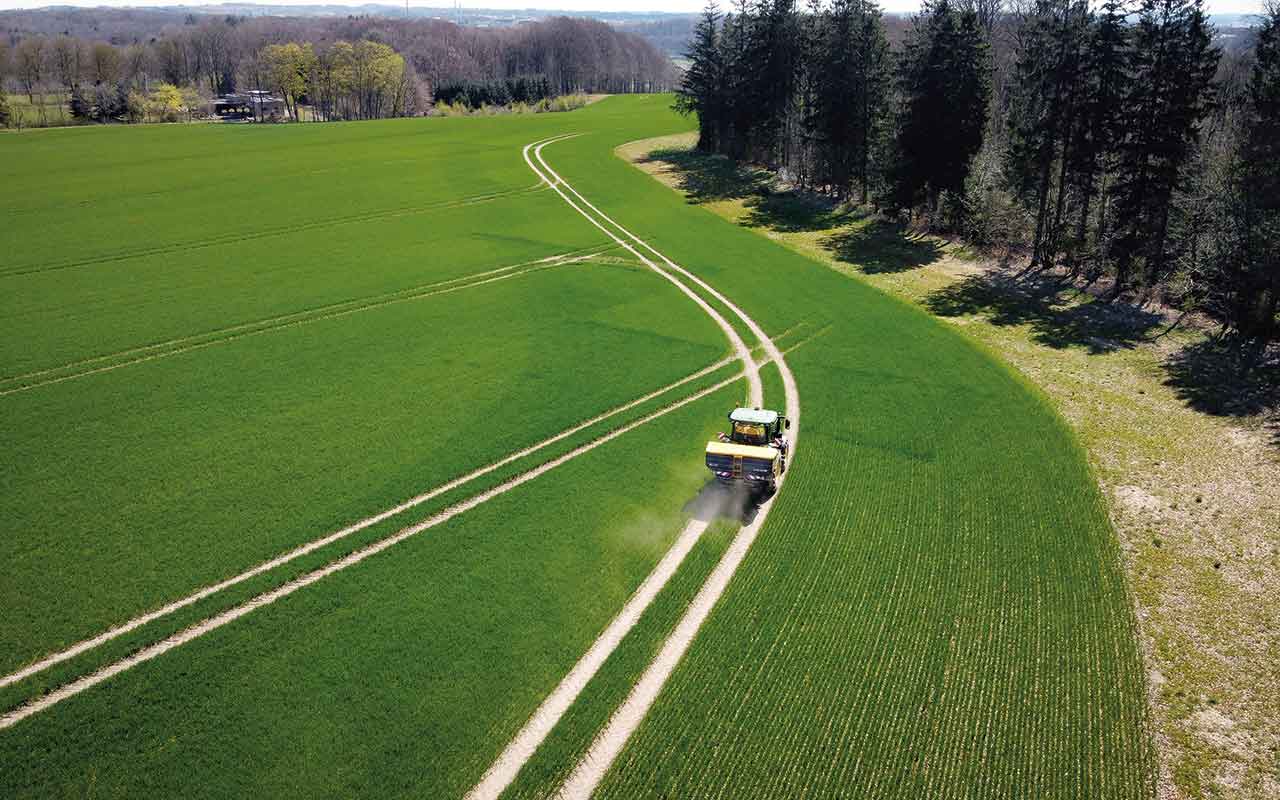
KRM
KRM recently introduced Dynamic Headland to its Bogballe fertiliser spreaders. This system is a further development of the Dynamic Section Control solution and uses the same hardware.
A key benefit is said to be ease of use, with the ability to freely switch between normal and headland spreading during operation. Headland spreading can also be performed to the left or right of the machine and several spreading modes can be selected to suit the situation.
This new headland spreading system has been developed for larger working widths of 27-42m. Three modes are available, allowing the operator to tailor the spread to the situation by adjusting both the rate and spread to either maximise yields or protect the environment.
The flagship mounted model in the KRM range is the M60W, offering a capacity of up to 5,500 litres and spread widths up to 42m.
The two stainless steel discs rotate towards each other to create a ‘double-double’ overlap, while blockages to the agitator are avoided thanks to a cone mounted under the screens in the hopper.
The company offers a range of Bredal trailed spreaders, increasing the capacities available and providing a possible working width of 48m.
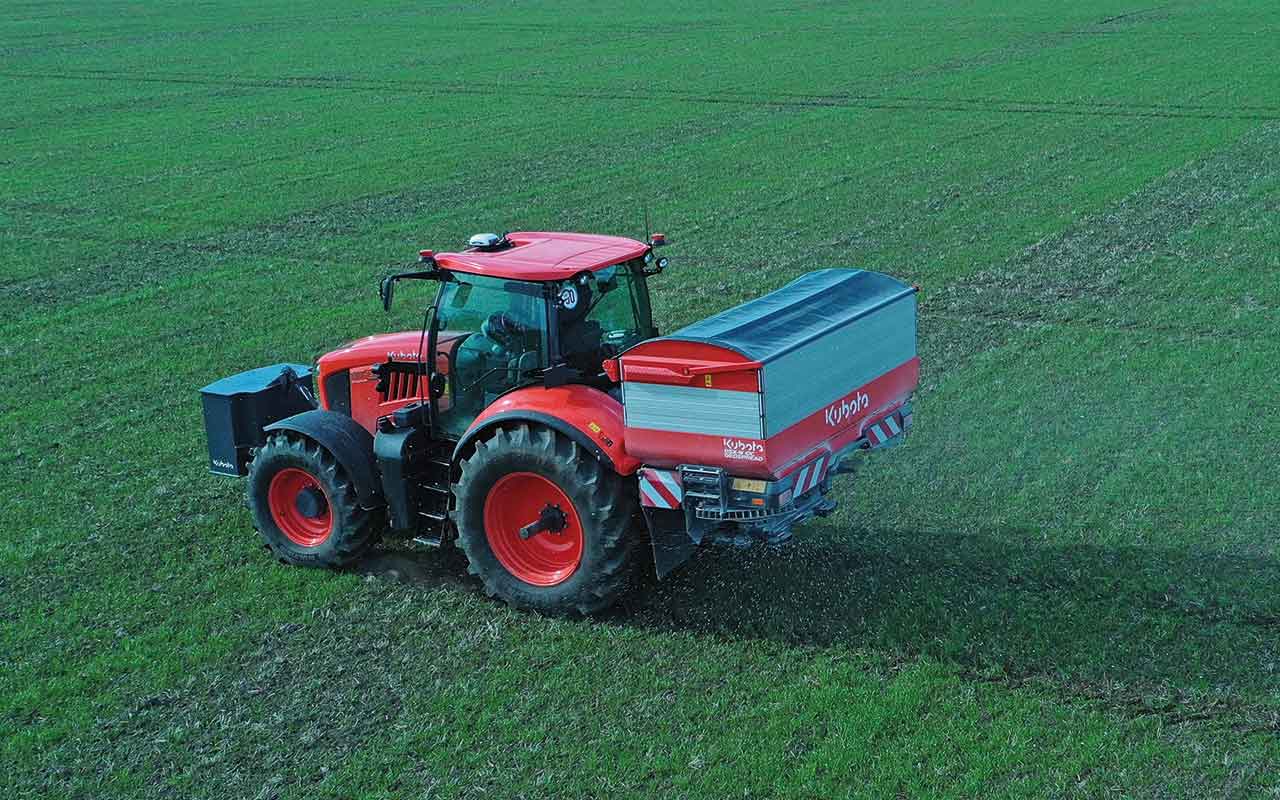
Kubota
Two new models have been added to the Kubota range of fertiliser spreaders, both featuring the iDC intelligent disc control system.
This enables the right and left disc speeds to be independently adjusted for accurate border spreading. Users can set up the system via the Autoset app and send it directly to the machine.
The DSX-W Geospread iDC is available with a capacity of 1,875 litres, with spread widths up to 54m possible depending on fertiliser type and quality.
There are extra models in the DSX-W Geospread range, with capacities across the series extending from 1,500 to 2,550 litres.
Each of these models benefit from Geospread application rate adjustment, as well as Geopoint headland management. As an option, Multirate enables multiple rates to be applied within the working width.
The 1,875-litre DSXL-W Geospread model has also been updated with iDC. According to the company, the RotaFlow spreading vanes, available across the spreader range, provides the perfect overlap thanks to the eight high-capacity vanes mounted on each disc.
Something unique to the Kubota Group is the ability to mount a Geospread spreader on the front and rear of the tractor, doubling the capacity and enabling two products to be spread in one go.
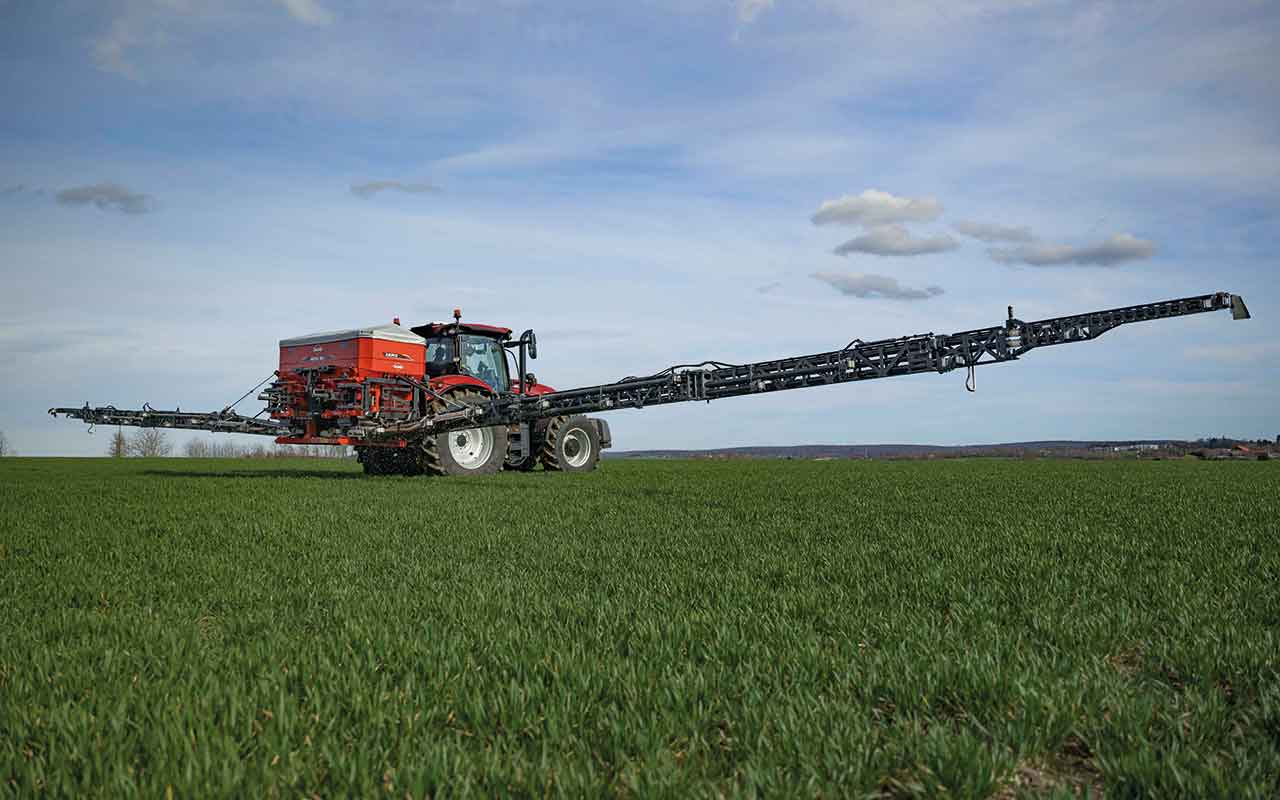
Kuhn Farm Machinery
Updates to Kuhn’s fertiliser range include the addition of the Aero 32.1 mounted boom spreader. The Aero 32.1 is capable of accurately applying different grades of fertiliser, granular herbicides and small seeds.
The machine can be equipped with four boom sizes – 24m, 27m, 28m and 30m – and allows precise application regardless of wind strength or granule quality.
It has a maximum 3,200-litre hopper, integrated weighing system and four hydraulically driven metering units. This enables Kuhn’s MultiRate 4 technology to apply four rates at the same time across the width of the boom to increase accuracy.
Boom height control via ultrasonic sensors is possible and it is compatible with Isobus terminals or CCI 880 or 1200 screens.
Optipoint PRO has been introduced to the range of Axis fert spreaders to avoid incorrect dosing on headland intersections when applying a wide range of fertilisers.
This changes the drop point to avoid application when the tractor starts turning onto the headland tramline. Instead, the spreading pattern and drop point of the headland pass are modified to the centre of the field to cover a greater area.
A wider internal headland is created, allowing spreaders to switch off earlier when applying field passes. Tailored settings can be used for different fert characteristics, with a lift of up to a +4 drop point, or up to +60% application rate.
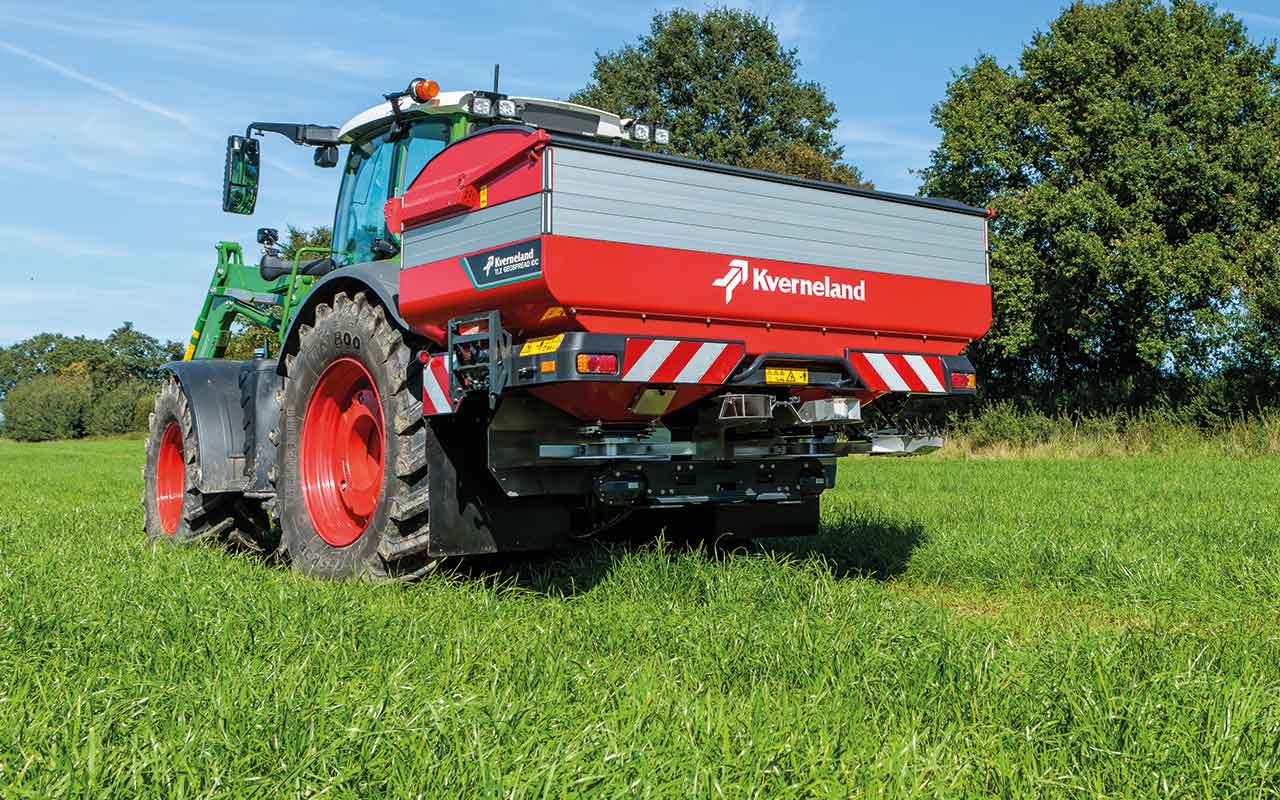
Kverneland
Kverneland’s largest fertiliser spreaders comprise the Exacta TL Geospread and the Exacta TLX Geospread, both available with Intelligent Disc Control.
They come with a continuous dynamic weighing system with automatic calibration for speed-related dosing and spread pattern correction when working on slopes. Weighing spreaders also come with Isobus as standard, with the IsoMatch Tellus Pro terminal in the cabin.
Using the Autoset app, which links to the tractor terminal, operators can access an online fertiliser database, providing the correct spreader settings for the type of fertiliser being applied. These settings can then be wirelessly sent to the machine.
The Geospread branding means the spreader can automatically adjust the working width based on the desired overlap using the GPS correction signal.
As well as the width, the rate is also adjusted to match. Using a variable-rate map, the Multirate system can handle up to eight different rates based on soil and crop requirements.
A key feature of the full Kverneland range is the centre flow spreading system, which accelerates the fertiliser up to the disc speed before it reaches the vanes.
This is said to reduce the impact of the granule hitting the disc, therefore reducing fragmentation and dust.
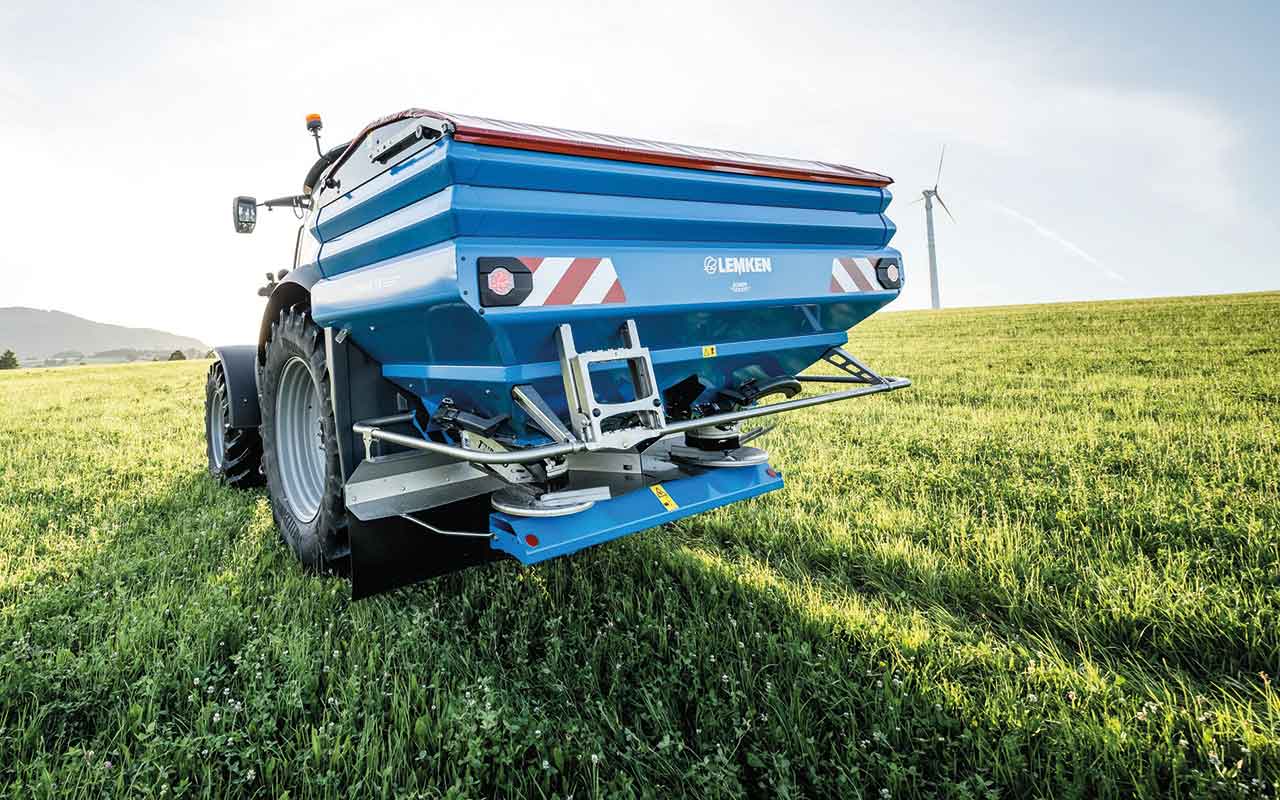
Lemken
The Polaris fertiliser spreader offers hopper sizes of up to 3,000 litres, working widths between 18m and 50m and full operability of all systems from the driver’s cab.
These include the new SpeedControl function for automatic spreading pattern adjustment. Changing the forward speed has a direct influence on the spreading pattern on the ground.
The GPS-supported EcoNov section control system automatically switches 12 crescent-shaped sections on the headlands or field wedges on and off as soon as there is a risk of unwanted overlapping or untreated sections.
Whether next to a body of water, a path or a neighbouring crop, the Tribord 3D border spreading system enables controlled application of the granulate.
Three different spreading modes can be set from the tractor cab. Depending on the selected mode, more or less fertiliser is fed to the special border spreading vane via an electric adjusting cylinder and the working width is adjusted accordingly.
Continuous automatic weighing during spreading ensures consistent fertiliser delivery even if the flow properties of the granulate change.
The integrated tilt sensor compensates for measurement deviations when working on slopes. The fill level of the hopper is displayed directly in the cab.
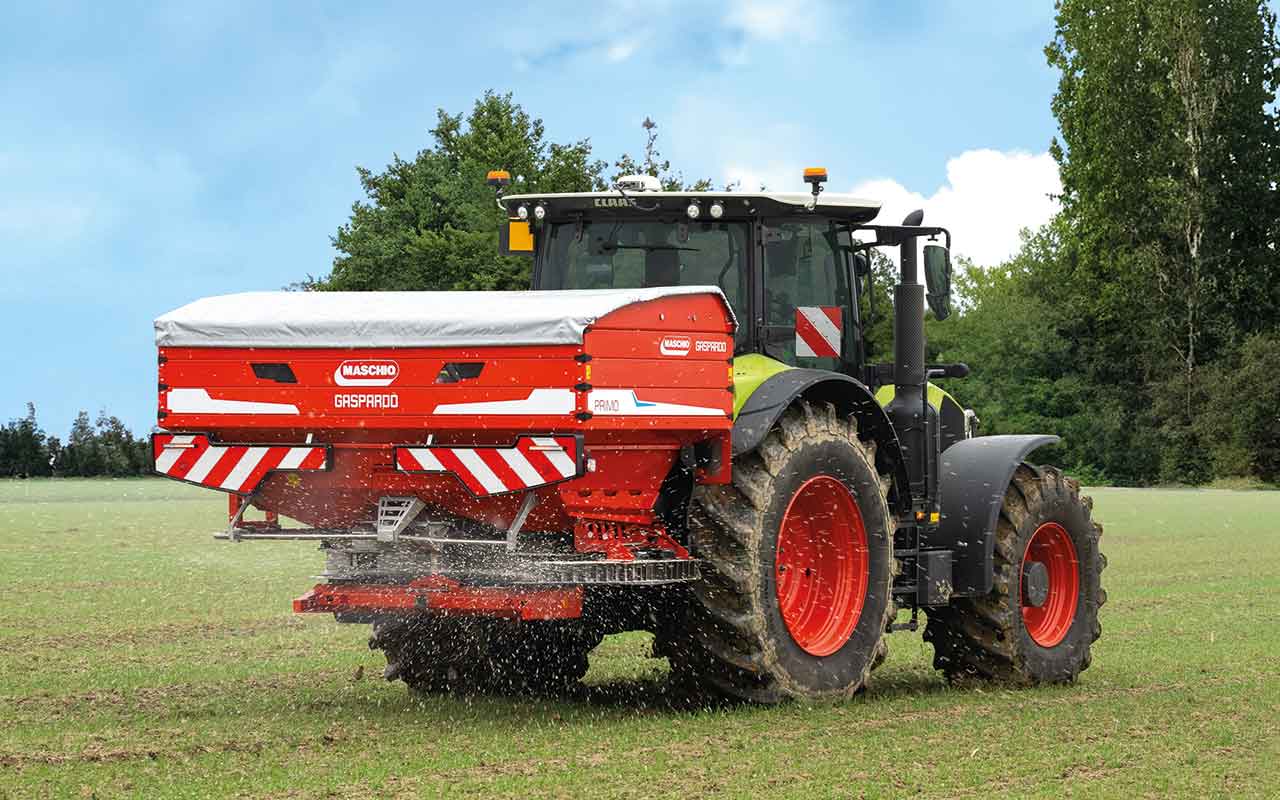
Maschio Gaspardo
The twin-disc Primo fertiliser spreaders from Mascho Gaspardo offer working widths from 12m up to 36m and hopper capacities from 1,270 litres up to 4,450 litres.
According to the company, the range-topping Primo EWH Isotronic is one of the most precise machines on the market. A twin-shutter system is fitted, with one pair of sliders handling rate control while the other shuts off fertiliser flow at the headlands.
Eight- or 32-section shut-off can be specified, achieved by altering the drop point on the disc via a three-lobe aperture.
This also enables the machine to handle application rates up to 640kg/ min. Isotronic machines are fully Isobus compatible, with operators able to manage the GPS section control and variable-rate applications (when weigh cells are fitted).
This system can independently adjust the rate on the left and right of the machine.
Even higher levels of precision are possible with the hydraulic disc drive, with an independent drive to each disc.
This means the speed of each disc can be controlled for additional accuracy, and disc speed is maintained regardless of the tractor engine speed or forward speed.
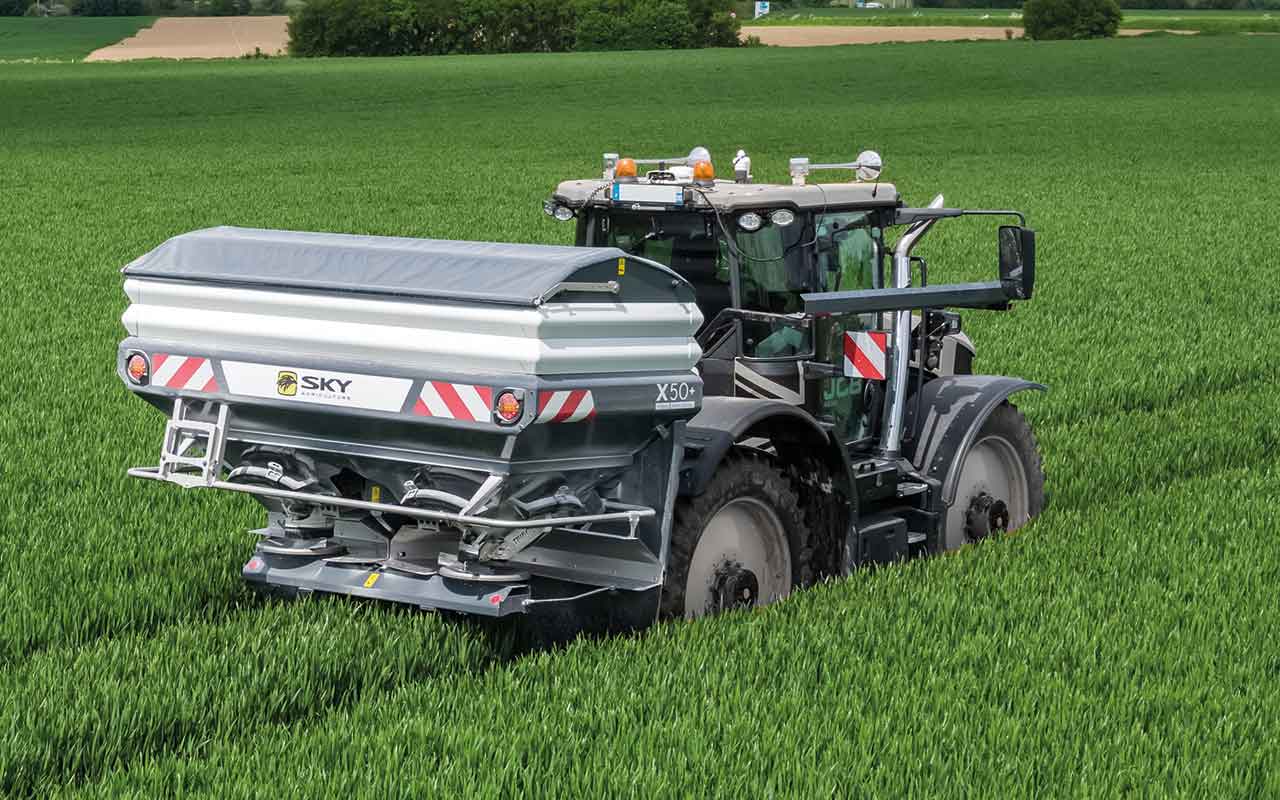
Sky Agriculture
The fertiliser spreaders sold in the Sky livery are a continuation of the range originally sold in Sulky blue following the decision to rebrand the Sulky Burel group as Sky Agriculture.
The range starts with the DX20 and DX20+ models, with hoppers ranging from 900 litres to 2,100 litres and a maximum spread width of 24m.
This working range extends to 36m as you move up to the DX30 models, with increased capacities of 3,000 litres.
Topping out the mounted range are the X40+ and X50+ models, with working widths of up to 50m and hopper sizes of 4,200 litres.
These flagship units come with the Econov system, which splits the spread width into 12 sections across a curve, instead of a straight line, for more accurate application.
Also available is the patented speed control system, which compensates for the application rate based on speed variations.
If greater capacities are required, the company also offers a range of XT trailed spreaders, available from 7,000 to 15,500 litres and capable of spreading up to 50m. These can also apply lime, either via the discs or using a 12m boom system.
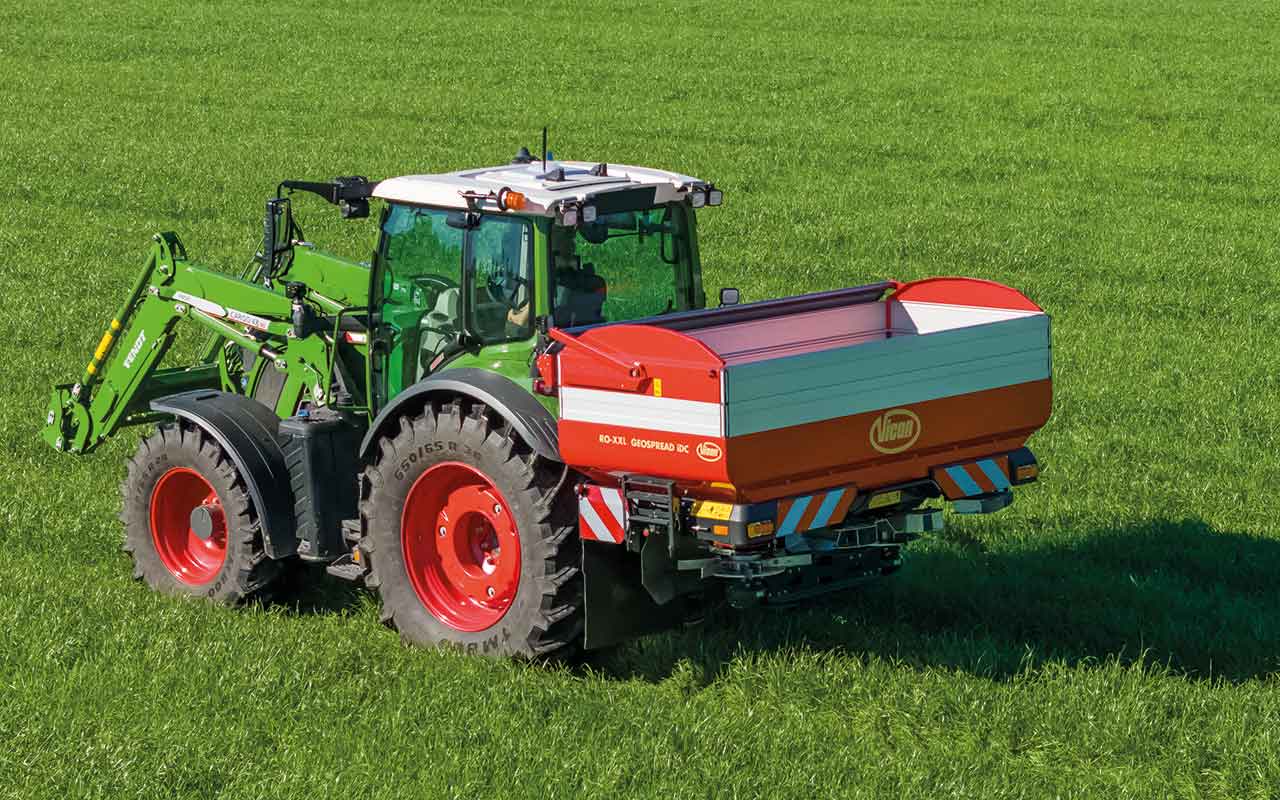
Vicon
Like with the other brands in the Kubota Group, the newest feature in the Vicon RO spreader portfolio is Intelligent Disc Control, providing independent speeds across the right and left discs for accurate border spreading.
It’s available on the RO-EDW Geospread, offering capacities up to 3,450 litres and spread widths up to 54m, and the RO-XXL Geospread, up to 3,900 litres and 54m.
On both ranges, section control splits the spread width to a minimum of 1m increments, with a maximum of 24 sections when using the IM Tellus terminal.
On the RO-EDW, the electronic weighing system is standard, which continuously monitors fertiliser weight, flow characteristics and the machine’s forward speed to adjust the spread pattern.
Optional on the EDW, customers can equip central hydraulic drive. When not optioned, both the EDW and XXL come with a centre gearbox with both high and low disc speed settings.
A lifetime LED lighting kit is fitted as standard, and it is possible to equip a fine application kit for the RotaFlow system, making it possible to spread seeds and slug pellets.


